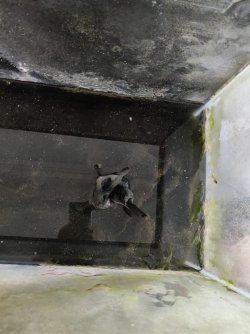wgoldfarb
Fish Fanatic
Up until 3 years ago I had a 29 gallon freshwater planted tank, and was an avid fishkeeper. I am originally from Venezuela so I had stocked the tank with fish from home: Black Bar Endlers (P. wingei), Venezuelan Pygmy Cories (C. habrosus), Red Phantom tetras (H. sweglesi), Green Neons (P. simulans) and a handful of small Otos (O. vitattus). Since I was a beginner and I had a medium-low LED light fixture I got a "beginner" plant package with an assortment of easy plants (planted on a substrate of Laterite topped with pool filter sand). Everything was going well. Soon I upgraded my light to a better, brighter fixture to give myself more options on plants, and I was even starting to use the Estimative Index to dose nutrients.
Then, for reasons explained in my introductory post, the tank sat abandoned for 2 years. I won't repeat all the details here, but you can imagine what I found when I finally returned home after 2 years of no maintenance whatsoever. Obviously all my poor fish died (and most of my plants), and the whole thing was overrun with slimy growths of many different colors. Part of the water had evaporated, so a lot of those growths had become dried and encrusted all over the tank walls, hoses, etc. Amazingly, the light, heater and filter were still running. As explained in the other post I was unable to clean the tank at the time, so I turned off the light, heater and filter, but had to leave the mess unattended until now.
I am now finally able to take care of the tank again, so I will rebuild and restart my 29g. Since I now have a bit more knowledge than when I first started and a better light fixture, my options for plants are broader so I am aiming for a more densely planted tank than I used to have. I will also relax my requirement to only have fish from home to give myself more options for stocking.
Still, choices for plants and fish will come later. My first step is to clean the swamp that currently sits inside my tank, so I have a clean slate to rebuild. I know I will have to ask lots of questions for that!
In a moment I will start by posting photos of what my tank used to look like before I abandoned it, and what it looks like today.
Then, for reasons explained in my introductory post, the tank sat abandoned for 2 years. I won't repeat all the details here, but you can imagine what I found when I finally returned home after 2 years of no maintenance whatsoever. Obviously all my poor fish died (and most of my plants), and the whole thing was overrun with slimy growths of many different colors. Part of the water had evaporated, so a lot of those growths had become dried and encrusted all over the tank walls, hoses, etc. Amazingly, the light, heater and filter were still running. As explained in the other post I was unable to clean the tank at the time, so I turned off the light, heater and filter, but had to leave the mess unattended until now.
I am now finally able to take care of the tank again, so I will rebuild and restart my 29g. Since I now have a bit more knowledge than when I first started and a better light fixture, my options for plants are broader so I am aiming for a more densely planted tank than I used to have. I will also relax my requirement to only have fish from home to give myself more options for stocking.
Still, choices for plants and fish will come later. My first step is to clean the swamp that currently sits inside my tank, so I have a clean slate to rebuild. I know I will have to ask lots of questions for that!
In a moment I will start by posting photos of what my tank used to look like before I abandoned it, and what it looks like today.



